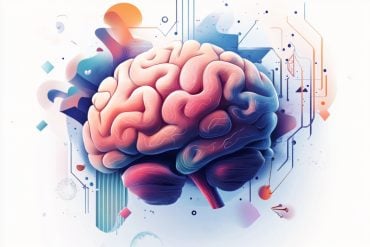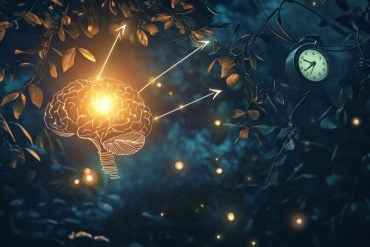Summary: A new study reports learning music can accelerate brain development in young children, particularly in areas associated with language development and sound processing.
Source: USC.
Five-year USC study finds significant differences between kids who learned to play instruments and those who didn’t.
Music instruction appears to accelerate brain development in young children, particularly in the areas of the brain responsible for processing sound, language development, speech perception and reading skills, according to initial results of a five-year study by USC neuroscientists.
The Brain and Creativity Institute (BCI) at USC began the five-year study in 2012 in partnership with the Los Angeles Philharmonic Association and the Heart of Los Angeles (HOLA) to examine the impact of music instruction on children’s social, emotional and cognitive development.
These initial study results, published recently in the journal Developmental Cognitive Neuroscience, provide evidence of the benefits of music education at a time when many schools around the nation have either eliminated or reduced music and arts programs. The study shows music instruction speeds up the maturation of the auditory pathway in the brain and increases its efficiency.
“We are broadly interested in the impact of music training on cognitive, socio-emotional and brain development of children,” said Assal Habibi, the study’s lead author and a senior research associate at the BCI in the USC Dornsife College of Letters, Arts and Sciences. “These results reflect that children with music training, compared with the two other comparison groups, were more accurate in processing sound.”
For this longitudinal study, the neuroscientists are monitoring brain development and behavior in a group of 37 children from underprivileged neighborhoods of Los Angeles.
Thirteen of the children, at 6 or 7 years old, began to receive music instruction through the Youth Orchestra Los Angeles program at HOLA. The community music training program was inspired by the El Sistema method, one that LA Philharmonic conductor Gustavo Dudamel had been in when he was growing up in Venezuela.
Learning the violin
The children earn to play instruments, such as the violin, in ensembles and groups, and they practice up to seven hours a week.
The scientists are comparing the budding musicians with peers in two other groups: 11 children in a community soccer program, and 13 children who are not involved in any specific after-school programs.
The neuroscientists are using several tools to monitor changes in them as they grow: MRI to monitor changes through brain scans, EEG to track electrical activity in the brains, behavioral testing and other such techniques.
Within two years of the study, the neuroscientists found the auditory systems of children in the music program were maturing faster in them than in the other children. The fine-tuning of their auditory pathway could accelerate their development of language and reading, as well as other abilities – a potential effect which the scientists are continuing to study.
The enhanced maturity reflects an increase in neuroplasticity – a physiological change in the brain in response to its environment – in this case, exposure to music and music instruction.
“The auditory system is stimulated by music,” Habibi said. “This system is also engaged in general sound processing that is fundamental to language development, reading skills and successful communication.”
Ear to brain
The auditory system connects our ear to our brain to process sound. When we hear something, our ears receive it in the form of vibrations that it converts into a neural signal. That signal is then sent to the brainstem, up to the thalamus at the center of the brain, and outward to its final destination, the primary auditory cortex, located near the sides of the brain.

The progress of a child’s developing auditory pathway can be measured by EEG, which tracks electrical signals, specifically those referred to as “auditory evoked potentials.”
In this study, the scientists focused on an evoked potential called P1. They tracked amplitude – the number of neurons firing – as well as latency – the speed that the signal is transmitted. Both measures infer the maturity of the brain’s auditory pathways.
As children develop, both amplitude and the latency of P1 tend to decrease. This means that that they are becoming more efficient at processing sound.
At the beginning of the study and again two years later, the children completed a task measuring their abilities to distinguish tone. As the EEG was recording their electrical signals, they listened to violin tones, piano tones and single-frequency (pure) tones played.
The children also competed a tonal and rhythm discrimination task in which they were asked to identify similar and different melodies. Twice, they heard 24 melodies in randomized order and were asked to identify which ones differed in tone and rhythm, and which were the same in tone and rhythm.
Children who were in the youth orchestra program were more accurate at detecting pitch changes in the melodies than the other two groups. All three groups were able to identify easily when the melodies were the same. However, children with music training had smaller P1 potential amplitude compared to the other children, indicating a faster rate of maturation.
“We observed a decrease in P1 amplitude and latency that was the largest in the music group compared to age-matched control groups after two years of training,” the scientists wrote. “In addition, focusing just on the (second) year data, the music group showed the smallest amplitude of P1 compared to both the control and sports group, in combination with the accelerated development of the N1 component.”
Co-authors of the study were BCI neuroscientists B. Rael Cahn, and co-directors of BCI Antonio Damasio and Hanna Damasio.
Funding: The study was funded by Brain and Creativity Research Funds.
Source: Emily Gersema – USC
Image Source: This NeuroscienceNews.com image is credited to Craig T. Mathew, Mathew Imaging.
Original Research: Full open access research for “Neural Correlates of Accelerated Auditory Processing in Children Engaged in Music Training” by Assal Habibi, B. Rael Cahn, Antonio Damasio, and Hanna Damasio in Developmental Cognitive Neuroscience. Published online April 16 2016 doi:10.1016/j.dcn.2016.04.003
[cbtabs][cbtab title=”MLA”]USC. “Music Training Helps Kid’s Brains Develop Faster.” NeuroscienceNews. NeuroscienceNews, 20 June 2016.
<https://neurosciencenews.com/neurodevelopment-music-training-4519/>.[/cbtab][cbtab title=”USC”]USC. (2016, June 20). Music Training Helps Kid’s Brains Develop Faster. NeuroscienceNews. Retrieved June 20, 2016 from https://neurosciencenews.com/neurodevelopment-music-training-4519/[/cbtab][cbtab title=”Chicago”]USC. “Music Training Helps Kid’s Brains Develop Faster.” https://neurosciencenews.com/neurodevelopment-music-training-4519/ (accessed June 20, 2016).[/cbtab][/cbtabs]
Abstract
Neural Correlates of Accelerated Auditory Processing in Children Engaged in Music Training
Several studies comparing adult musicians and non-musicians have shown that music training is associated with functional and anatomical brain differences. It is unknown, however, whether those differences result from lengthy musical training, from pre-existing biological traits, or from social factors favoring musicality. As part of an ongoing 5-year longitudinal study, we investigated the effects of a music training program on the auditory development of children, over the course of two years, beginning at age 6-7. The training was group-based and inspired by El-Sistema. We compared the children in the music group with two groups of “control” children of the same socio-economic background, one involved in sports training, another not involved in any systematic training. Prior to participating, children who began training in music did not differ from those in the control groups relative to cognitive, motor, musical, or brain measures. After two years, we now observe that children in the music group, but not in the two control groups, show an enhanced ability to detect changes in tonal environment and an accelerated maturity of auditory processing as measured by cortical auditory evoked potentials. Our results suggest that music training may result in stimuli specific brain changes in school aged children.
“Neural Correlates of Accelerated Auditory Processing in Children Engaged in Music Training” by Assal Habibi, B. Rael Cahn, Antonio Damasio, and Hanna Damasio in Developmental Cognitive Neuroscience. Published online April 16 2016 doi:10.1016/j.dcn.2016.04.003







